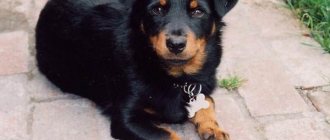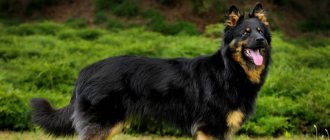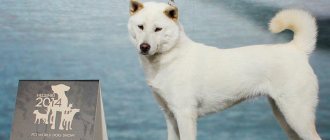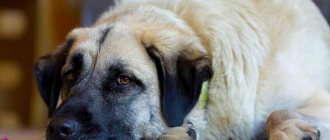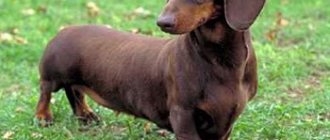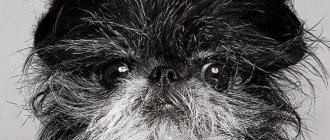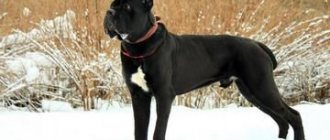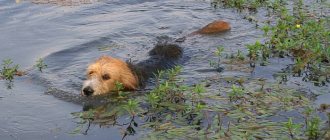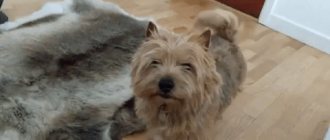Description and features
Despite the fact that the Lancashire Heeler has not been officially adopted, some parameters are considered mandatory for this dog.
- The physique is strong, harmoniously built. Outwardly, the dog looks squat, but quite powerful. The body is longer than it is tall; such animals are said to have a “rectangular body.” The body is distinguished by a straight, strong back, a fairly powerful chest and rounded hips.
- The ideal height for males is 30 cm, for females – 25 cm.
- The coat should completely hide the undercoat. Color: dark chestnut (almost black) or red with tan. The coat looks shiny, feels rough and smooth. The undercoat protects the dog in any bad weather and allows the dog to remain dry in rain and snow. In winter, the “robe” becomes longer and denser than in the summer, and a “scruff” is noticeable. Regarding color, the color usually looks like black or brown with tan. A white spot on the chest is allowed. But these “colored” deviations are recognized by the Kennel Club.
The standard does not specify weight and some other characteristics, but breeders prefer to indicate them:
- Weight can range from 3 to 8 kg
- The ears are triangular in shape and set wide apart. When tense, they can be slightly tilted forward, but stand in a calm position.
- The head is slightly flattened vertically, wedge-shaped in shape. The eyes are almond-shaped, medium in size, usually brown and very expressive. The bite is correct, scissor-shaped. The teeth must be completely complete.
- The paws are short but strong, broad-boned, with well-developed muscles. The hind legs may be slightly turned outwards, but this should not affect movement.
- The tail is quite long, slightly curved at the end, set high, thick at the base, and always in motion. It is not customary to buy it.
Despite its rather small size, the Lancashire Heeler dog is distinguished by unexpected strength and excellent working abilities. In addition, they must be “energetic and alert,” according to the same unwritten standard.
Personality of the Lancashire Heeler
The Lancashire Heeler's personality is more similar to that of a Shepherd than a Terrier. These small dogs are very active and are suitable for keeping in an apartment because they do not need long walks, although they are happy to walk with their owner. They love to play, they are always cheerful and playful.
The duties of a Lancashire heeler include driving cattle, as well as sheep and horses. His instincts as a shepherd and hunter help him cope with hunting rats and other small rodents. It can also be used as a guard dog.
The Lancashire Heeler was bred to demonstrate how a small dog can herd cattle into a specific area. Today, the Lancashire Heeler can be found on sofas in fashionable salons, in particular those of Queen Elizabeth II. This little dog has the best character among the miniature dog breeds.
The Lancashire Heeler gets along well with children and quickly becomes a favorite of the whole family. His goodwill and calm disposition, cheerful facial expression and small size allow him to be used as a companion. It is also used in special therapy for the disabled and elderly.
The Lancashire Heeler is highly trainable and is always happy to please its owner. These dogs need the love of their owner, otherwise he will not show all his natural abilities.
Lancashire Heeler dog. Description, character, characteristics, care and breeding
Kinds
Since the breed is still in the development stage, there are different types of specimens among it. The main differences are in the color and structure of the coat. However, it is not distinguished by variety. Rather, it can be divided into several types according to use:
- shepherds and beaters;
- hunters and watchmen;
- companions and assistants who are always nearby, at your feet (actually “heeler” can be translated from one of the English slangs as “henpecked”),
- sporting dogs;
- rescue dogs.
All these qualities, in fact, can be inherent in the same dog. We can say that the Lancashire Heeler is a universal dog. Closest relatives are Welsh Corgis (Welsh Corgis) and Manchester Terriers. A few words about these breeds.
Welsh Corgis (Pembroke and Cardigan) - according to Welsh legend, these dogs were a gift to humanity from fairies, because people supported them in their conflict with greedy gnomes. Dogs have darker colored fur on their backs, like a saddle, which was used by the winged fairies who chose these animals to travel.
Legendary shepherd dogs look a bit like fox cubs, with lots of light red, smooth fur combined with soft white fur. Three colors are also allowed within the breed - red-white-black, just black (rarely) and brindle colors. White markings are possible with any color.
Short legs, erect ears, squat long body, medium-length tail and very attentive brown eyes. This charming dog has an ancient pedigree, belongs to the Shepherd Dogs, and is truly considered a royal breed. In the early 30s of the last century, Queen Elizabeth II of England received a representative of this breed as a gift from her father.
Manchester Terriers are also a British dog breed, developed in the early 19th century. It owes its appearance to the struggle of the British against unsanitary conditions at that time, in particular, against the rats that infested the country. The fighting and swift dog successfully coped with its task. His tenacious grip and strong jaws allowed him to practically tear his victim in two.
Their size did not exceed 40 cm, weight was about 5-8 kg. The British carried a small hunter with them in special leather bags. The coat is smooth, black and tan in color, the ears are usually half-dropped, but erect when tense.
One of the oldest official terrier breeds. The Lancashire Heeler in the photo may remind someone of a Welsh Corgi, but a connoisseur will immediately see the differences. The Lancashire is distinguished by its smaller size, higher paws and rounded head shape.
Origin story
Dog handlers believe that the breed is ancient; they prove this with drawings and historical facts from the 15th-17th centuries. There is no further information about the breed until the 60s of the last century. There was a great threat of loss of the breed; it was during this period that they began to renew the breed.
Manchester Terriers were crossed with Cardigan Welsh Corgis.
To determine “defective” specimens, it was necessary to cross them with each other. This is how we got the Lancashire Heeler.
This breed cannot quickly produce large offspring, since one dog produces up to 4 puppies per year. In one year, three hundred puppies are born in the world, and there are four thousand in total.
History of the breed
As is often the case with ancient breeds, it is difficult to determine their exact origins. One thing is certain - Lancashires appeared in England. Once upon a time, more than 200 years ago, a breed of Welsh Corgi was used to herd domestic animals from Wales to the northern and western parts of England.
In the Ormskirk area, whether by accident or design, one of the Welsh Corgis crossed with a black and brown Manchester Terrier. This is presumably how the Lancashire Heeler breed . By the way, in her homeland she is also called Ormskirk heeler or Ormskirk terrier.
In its area, this dog has become quite popular among livestock owners. She did an excellent job as a driver and shepherd. Gradually, the breed died out, until in 1960, dog enthusiast Gwen McIntosh began actively restoring the dog.
In 1978, she and other breeders formed the Lancashire Heeler Club and became its president. They developed an initial breed standard and registered. Recognition by the English Kennel Club followed in 1981. Gwen McIntosh continued to serve as president until her death in 1992.
In 2006, the breed was recognized as vulnerable local. This meant that annual registration numbers did not exceed 300. In 2016, the Fédération Cynologique Internationale added the breed to its list of provisionally accepted breeds.
Basic moments
- The Lancashire Heeler is small in size, weighs from five to eight kilograms and grows up to thirty centimeters at the withers,
- The following adjectives can be used to describe this dog: smart, playful, friendly, always full of energy, invigorating and funny. Overall, this is a great companion
- While they are excellent herders (which is what they were bred for), they are also capable of other jobs and are generally multi-functional.
- Excellent adaptability allows them to get along well with both adults and children, or with other pets. The only problem is their reaction to strangers - they show aggression towards those they consider intruding on their territory.
Character
Despite the fact that the Lancashire Heeler was bred to work in open spaces and on the street, the pet gets along well with all family members and pets. The dog is affectionate, cheerful, smart, loves everyone. Infinitely devoted to her “pack”. He is wary of strangers.
The character of the Lancashire Heeler is closer to that of the Sheepdogs, which are its supposed ancestors, the Welsh Corgi. These animals are active, smart, and respond well to a city apartment. They love to play ball games or simply run after their owner.
As already mentioned, the working purpose is to corral cows, bulls, sheep, horses and other farm animals. And also hunting for rabbits, rats, guard work. She has excellent reactions, convenient sizes and a friendly disposition.
Thanks to this, the dog is often taken as a companion and also a friend for children. In addition, it is used in rehabilitation centers for the disabled and in nursing homes in canistherapy (treatment with dogs). Can participate in various dog competitions in agility, flyball (a canine sport using a ball), show skills and team competitions.
It is advisable to engage in training from a very early age. These pets try to please their owner and are always happy to learn, so they are subject to training. The Lancashireman needs to be loved and given more attention, then he will become the dog you dreamed of.
Character and behavior
If you are looking for a true friend and guard, then you are in the right direction! Loyalty to the owner and protection of the home in this breed greatly predominate in its character. Just as they love affection, they actively give it away. Dogs are friendly towards other pets, try not to have small animals, as instinct can wake up at any moment and your pet will go hunting.
It is better not to leave this breed alone at home, the dog will begin to suffer and may acquire bad behavior or habits. The Lancashire Heeler, when busy with work, can quietly spend time alone, but his sociable qualities and friendliness will get the better of him very quickly.
Lancashires love children very much and will be good nannies.
These dogs love walks, games and even running, because for them movement is everything!
Nutrition
Lancashire Heelers are unpretentious eaters. The diet of an adult dog can consist of natural products, where the basis is boiled meat. One fifth of the menu can be made up of cereals, boiled vegetables, and sour-milk products. You can choose premium or holistic food (natural based). In both cases, include fresh vegetables and fruits in your diet.
At first, it is recommended to give puppies cottage cheese, other fermented milk products, cereals, eggs, then you can switch mainly to a protein diet (meat). Or also choose a good ready-made food for active puppies. Having clean and sufficient drinking water is essential for Lancashire residents.
Description of the Lancashire Heeler
The Lancashire Heeler is a small, squat dog with a very strong build. Mostly black and tan.
- The head is shaped like a fox, the transition from the forehead to the muzzle is weakly defined
- The skull is slightly shortened
- The muzzle tapers towards the nose.
- The ears are set quite wide, triangular in shape, erect.
- Eyes: round, dark, located on a line running from the tips of the ears to the nose, medium size.
- The nose is black.
- Scissor bite.
- The neck is long.
- Legs are short, muscular, strong.
- Paws oval, arched
- Body: elongated, with a wide and deep chest and rounded ribs.
- The chest is round in shape
- The tail is set high, sickle-shaped, rather short, and not docked.
Height – 25.5–30.5 cm. Weight – 3-6 kg.
Reproduction and lifespan
Breeding these dogs is best left to professionals, because the important factor of paperwork, as well as the nuances and difficulties of obtaining a purebred breed, can be difficult for a beginner. Therefore, trust experienced breeders and buy yourself a purebred puppy from trusted nurseries.
From the first days a puppy appears in the house, the owner is obliged to take care of its upbringing and socialization. The optimal age for this is 2-3 months. It is important to show your pet the world around him, other animals, including cats. It is necessary to train the puppy not to “herd” people - not to grab ankles, even when playing.
Lancashire Heeler puppies need a dominant trainer because they are stubborn and intractable from childhood. It is through training and education that these qualities will be overcome. Just don’t use rudeness or violence against them.
Average life expectancy is 12-15 years. Diseases: Collie eye anomaly, dislocation of the primary lens (eye lens), persistent pupillary membranes. May suffer from a dislocated kneecap.
Personality and character
Heelers have a very bright temperament. They are active, sociable, very smart and easy to train. They love to hunt outdoors and herd animals, or just sit at home, that's fine too. Sometimes they are stubborn and independent, and find themselves in unpleasant situations, but a strict and fair owner, who is an authority for them, will be able to keep them in line.
Using your influence and power will help keep their temperament normal, but you should also not forget about various training and activities. Their personality and character are ideal for exhibitions, where they demonstrate learned tricks, physical characteristics, as well as their level of obedience.
This breed must be socialized from puppyhood , as it has a tendency to show wariness and suspicion towards people around it (with the exception of loved ones), which sometimes results in aggression.
Care and maintenance
The coat is short, but two-layered. The outer layer is dense, smooth, and protects the dog well from bad weather. There is a “collar” around the neck. The undercoat is dense, soft and fine. Shedding is seasonal - in autumn and spring.
It needs to be brushed with a stiff brush once a week, and bathed only when absolutely necessary. What is really important to keep an eye on is your teeth, eyes and ears. All this must be cleaned every week and checked for disease.
You can get by with a short walk when the owner has little time. However, if you give him a real workout in the form of running or playing, he will be tired, but truly happy. It would be ideal if he could feel needed and useful. For example, being a shepherd or hunting rodents.
general characteristics
Previously it was used mainly for shepherding. Today the function of dogs remains unchanged. This is a very strong animal for its modest size. He is most often put to graze cattle: cows, horses, sheep.
A dog can be a good guard, a hunter of small rodents, a devoted family or show pet. Recommended for children or elderly people. Loyalty and lively disposition allow her to delight her owners every day.
According to the breed standard, the dog's height at the withers should range from 25-31 cm, and its weight should range from 3 to 6 kg.
Price
At the moment, the Lancashire Heeler in Russia is a very rare dog. We do not have nurseries that purposefully breed this animal. Therefore, the bulk of purebred Lancoshires come to us from abroad - Finland, England and Holland. The price of a Lancashire Heeler abroad ranges around $400-450. Considering transportation, it will be more expensive.
It is possible that buying a puppy from our country could cost you about $1,000. When purchasing a purebred Lancashire, you must ask for documents about the purity of the breed, about all vaccinations carried out, in order to exclude getting an unhealthy puppy or a fake. You can find several groups on social networks where there are options for purchasing or selling puppies of this breed.
Education and training
The puppy begins to be raised as soon as the dog crosses the threshold of a new home. Firstly, you need to immediately accustom your pet to using the toilet outside. After a short amount of time, the puppy begins to ask on its own.
Due to the specific nature of the breed, dogs tend to herd all the inhabitants of the house by pinching the legs with their front teeth . This will be weaned off gradually if the healer’s purpose is not in the field of cattle breeding.
Until the age of six months, the dog is methodically taught commands independently. But due to the stubborn and willful nature of Lancashire, from six months on it is better to resort to the services of a professional trainer .
For the purpose of socialization, the heeler is walked in crowded places on a leash. Only after the dog has learned a number of commands can the pet be allowed to run freely in deserted places, where there is no traffic.
Healers are smart enough to perceive and remember every command well . If the training process is carried out with a significant amount of love and affection, the dog becomes obliging and performs every exercise with precision.
Interesting Facts
- Despite the fact that it is generally accepted that the origin of the breed dates back to the late 18th and early 19th centuries, very similar dogs were depicted in ancient paintings found in Wales and having a more ancient history. Short-legged black-brown dogs, very reminiscent of the Lancashire terrier, were carefully depicted in a scene from the village life of ancient Welsh shepherds. This leads to the idea that the breed is much older than is commonly believed.
- Lancashire Heelers are commonly called “smiling” dogs. Indeed, their inherent friendly “smile” has already become a proverb, which is why the dog is often used in homes for the disabled and the elderly. They help brighten the lives of sick people.
- Under no circumstances should you purchase a pet from a poultry market. This is such a rare breed that ordinary sellers will not even undertake to sell purebred puppies. You will almost certainly buy a fake.
- Almost all pedigree dogs have two names - official according to documents and home. The first is used in the exhibition career, is included in diplomas, and the home one is used in the family; it remains with the pet for life.
Where to buy a puppy?
We have already said that the Lancashire Heeler is a rather rare breed in Russia. It is still quite difficult to find a nursery. You can contact the Flying Spitz kennel (Moscow region) or Ribessita (Estonia). The Faleser Hogland nursery, located in the city of Murom (Sovkhoznaya St., 11), receives good reviews. He specializes in breeding the Lancashire Heeler. Puppies are sold with all accompanying RKF documents, brand, veterinary passport. A purchase and sale agreement is drawn up. Those who need a Lancashire Heeler should know: the price of a puppy can vary from 45 to 60 thousand rubles.
